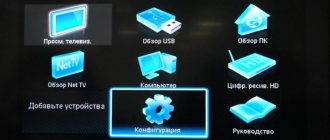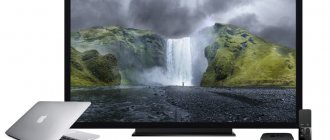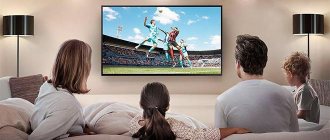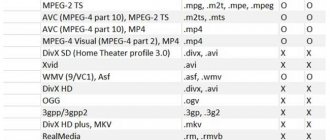Now satellite television has developed to an unprecedented level. Now, using cardsharing , you can watch any movie, TV program or series in high quality. However, as a result of this development, a huge number of different formats have appeared. In this article we will try to explain all the most important aspects regarding formats, frame rates, resolutions and much more.
| The difference between HD and SD video broadcasting |
Where to find HD channels
Modern digital television broadcasts the signal over the air using the DVB-T2 standard. This standard does not provide broadcasting of channels in high definition HD. However, the President of the Russian Federation signed a decree on the need to ensure the technical ability to transfer digital terrestrial television channels to HD broadcasting by 2021.
Today, to enjoy watching channels in high definition Full HD, you need to connect to satellite or cable television.
How can HDTV be broadcast and what are its prospects in Russia?
The means for broadcasting HDTV are similar to those used for conventional television. These are terrestrial, cable, satellite and IPTV. The most effective option is terrestrial television, but in the absence of digital TV in Russia, as well as uncertainty with providers and leasing frequencies, this option cannot yet be considered. Cable television has a better chance of success, but there are problems here too, the main one being the lack of infrastructure for signal transmission. Things are better with satellite television. Today, broadcasts of HD content have already begun. The only pity is that in our country there is very little competition in this area, and not everyone who wants can install a satellite dish for objective reasons, especially in a metropolis. IPTV is one of the most promising and universal methods of video transmission. The only limitation for starting HDTV broadcasts today is the need to implement the ADSL2+ standard, which, unlike the current ADSL2, has sufficient bandwidth for HDTV broadcasts. IPTV can also be broadcast via a local network or the Internet. In the latter case, the problem of creating infrastructure is completely solved - all that remains is to wait for the moment when domestic Internet providers can provide the necessary bandwidth. And judging by the pace of development in this area, this could happen within the next two years.
In preparing this FAQ, materials from the printed magazine HDTV.ru were used
Differences between HD and Full HD
Modern high-definition television standards provide for a number of lines of 720 (HD) and 1080 (Full HD), which provide high image quality. Full HD is not a separate standard - it was a marketing ploy invented by Sony in 2007.
A Full HD TV can play content or display pictures in other resolutions: SD or HD. But this will affect the low quality of the image.
The DVB-T2 standard has been adopted as the main format for digital terrestrial TV in Russia. The broadcast is in a resolution of 720 by 576 pixels - SD quality. When viewing SD resolution on an FHD TV, the TV matrix will need to “stretch” the lower resolution to the desired one.
For the consumer, the difference between Full HD and HD is the image quality. The image is clearer, the picture is detailed, you can see all the little things.
Permission
| Name | Resolution (pixels) |
| SD | 720×480 |
| HD-Ready | 1280x720 |
| Full HD | 1920×1080 |
| Ultra HD | 3840x 2160 |
| 4K DCI | 4096 x 2160 |
| 8K | 7680 x 4320 |
A large amount of content was shot with SD resolution, and if you have a TV with a declared FHD resolution, then TV shows in SD and HD-Ready formats will be shown in poor quality. There will not be enough pixels in the original frame for scaling and artifacts will be noticeable when stretched to Full-HD.
Screen size and aspect ratio
All standard definition systems have a 4:3 aspect ratio. Analogue and digital broadcasting have used PalPlus in addition to Pal since the late 90s. This is a modification of Pal with an aspect ratio of a 16:9 television frame and an increased number of elements per line - 1024, instead of the standard 720. All high-definition television standards were originally developed with an aspect ratio of 16:9, which allows most TV formats to best fit into the TV screen. cinematic origin.
Scanning progressive and interlaced
Of the existing technologies for outputting a television signal, progressive (1080p) signal scanning is the most acceptable, since with its help the picture is scanned completely line by line 16 times per second.
To display images on computer monitors, the image is displayed line by line and the flickering effect is completely eliminated. What is important for surveillance systems. When a camera captures a moving subject, the clarity of individual frames depends on the technology used. Progressive scanning involves transmitting a signal at a rate of 50 frames per second. Progressive scanning has long been used in computer technology and helps to avoid the comb effect that is clearly visible with interlaced scanning.
The desire to improve the quality of the transmitted image and get rid of blur or intermittent motion gives rise to new technologies for signal transmission and processing.
Matrix type
For a TV matrix, the main characteristic parameter is resolution.
A plasma panel is a pair of thin glass plates, the space between which is filled with microcapsules containing an inert gas.
The liquid crystal screen (LCD) appeared after plasma screens; it is based on a liquid that has a crystal lattice, color filters and a light source.
The first models of LCD TV screens were backlit with a fluorescent lamp. There was no way to highlight one pixel. Because of this, the image contrast is low. LCD TVs with direct LED backlighting have the following advantages:
- light, thin body - 2-3.5 cm;
- spot illumination, which improved contrast;
- adjustable brightness of individual screen areas;
- improved color rendering, good viewing angle;
- low power consumption.
OLED - organic light emitting diodes. They replaced filters with gratings. Using this technology, 3-4 organic LEDs are placed in each individual pixel (image point).
Diodes emit light in the blue, red, white and green spectrum. Combinations of these colors give many shades. The graphics processor controls the LEDs. On OLED screens, the eye can distinguish thousands of shades of gray and absolute black. The contrast and detail of the picture is excellent.
QLED technology was born at Samsung. Quantum dot LEDs are used here. Quantum dots emit their light when illuminated by backlight light.
For TVs with a diagonal larger than 40 inches, it is better to choose a UHD resolution of 3840 x 2160 pixels. For screens smaller than 40 inches, Full HD 1920x1080 pixels is good.
Also, when choosing a TV among different matrices, pay attention to the contrast of the display.
Price
The price of Full HD TVs is of primary interest to consumers. With the advent of TVs with FHD matrices, the price of equipment with HD matrices has dropped sharply
This price drop also occurred with the advent of television receivers with Ultra HD resolution. Subsequently, the same price reduction occurred with the advent of new technologies for the production of matrices based on organic light-emitting diodes and quantum dots.
Everything can be found out by comparison. And we will compare the image quality of HD with FullHD. Then Full HD c Ultra HD, etc. With a competent approach, the comparison may not be in favor of new technologies. And all because there is not enough content to watch in super quality yet.
Differences between image clarity formats
Resolution is one of the main parameters of digital television, responsible for image clarity and measured in dots per inch (pixels).
Main image formats:
SD (SDTV) - 720 × 576 pixels - standard definition.
HD (HDTV) - 1280 × 720 pixels - high definition, more detailed image.
Full HD (HDTV)
— 1920 × 1080 pixels is one of the most common formats today, 5 times superior to the capabilities of standard definition television, with a very realistic picture and the ability to see the smallest nuances.
Ultra HD (UHDTV, 4K)
- 3840 × 2160 pixels - an ultra-high definition broadcast format that features even higher quality images with incredible detail and color depth.
Tricolor was the first in Russia to launch broadcasting in Ultra HD format and offers the largest selection of satellite UHD channels *.
Modern receivers make it possible to watch more than 200 channels, including in HD and Ultra HD formats. But it should be clarified that the quantity and quality of received TV channels depends on the signal format that the receiving equipment supports and the technical capabilities of the TV.
Which TV channels as part of Tricolor services are broadcast in Ultra HD format?
Eurosport 4K
(6+) is a 24-hour channel that broadcasts key events from the world of sports in ultra-high quality. Four Grand Slam tournaments, cups and world championships in biathlon and alpine skiing, grand tours in cycling, world events in snooker, motorsport, athletics and water sports.
Russian Extreme Ultra
(16+, 18+) - 24-hour sports and entertainment channel. We air our own projects (“Extreme Zone”, “Extreme Lessons”, “Extreme Cuisine”, etc.) and programs dedicated to snowboarding, skateboarding, mountain biking, BMX, mountaineering, parkour, auto and motor sports, and exotic travel.
Ultra HD Cinema
(16+, 18+) - dynamic and spectacular action films, box office releases and films starring famous actors. It is also one of the first TV channels to offer viewers Dolby Digital 5.1 surround sound.
CINEMA UHD
(12+, 16+, 18+) is a film channel that airs a wide range of genres of foreign and Russian cinema.
UHD SERIES
(12+, 16+, 18+) - a 24-hour TV channel with popular series in ultra-high definition format: family comedies and historical epics, crime dramas and psychological detective stories.
INSIGHT UHD
(6+, 12+, 16+) is a TV channel whose main areas of focus are innovative documentaries, reality shows, extreme travel, sports and interactive projects.
FASHION ONE 4K
(0+, 6+, 12+, 16+, 18+) is the first and only Ultra HD channel dedicated to fashion, entertainment and lifestyle. It is part of the Fashion One television network.
"Eromania 4K"
(18+) is a channel with beautiful films for adults from the world's leading studios creating erotic content.
"Promo Ultra HD"
(18+) - premium quality channel in Ultra HD (4K) format. Incredibly realistic image, stunningly rich colors, high level of detail.
Love Nature 4K
(0+) is a channel about wildlife, which broadcasts amazing stories about the fascinating life of animals and exciting travels. The whole family can enjoy the beauty of our planet in the smallest detail and amazing quality.
Modern resolution UHD, 4K, 8K
The rapid development of technologies that improve the quality of transmitted images has led to the emergence of new standards. This is how devices with Ultra HD, 4K, 8K resolution appeared. These standards exceed cinematic quality.
Work to improve video quality knows no bounds. HDR technology appeared after the transition to 4K resolution. Technically, HDR refers to a new video signal format that contains not only ultra-high resolution, but also color and brightness information for each pixel.
TV receivers with a 10-bit matrix are capable of maximizing HDR video.
Hollywood films are shot using Dolby Vision technology, an advanced version of HDR. In the near future, this standard may appear in our media space.
Satellite TV and Internet 8-903-630-70-30
The development of television, especially digital, has brought both many benefits and many headaches. The main advantage of the new era of television is high image quality. Well, as a headache, this is, first of all, the problem of formats, there are now many of them. And once upon a time there was only one, with a resolution of 720x576.
Video formats. For comparison, we have two main video formats: the familiar standard SD and the new HD video formats. The detail of the HD image, thanks to the repeated increase in the number of points that make up the frame itself, is five times greater than the detail of its predecessor. Digital video includes two leading resolutions: 1920x1080, 1280x720. in any of these two resolutions the sides are in a 16:9 ratio. The old, outdated SD video format has a different aspect ratio - 4:3. This difference in aspect ratios can be explained by the fact that in the SD format the pixels are not square, they are shaped like a rectangle. These formats also differ in scanning. The standard SD format uses interlaced scanning. In digital HD format, progressive scan is also used. This made it possible to get rid of such negative qualities as “comb” or “comb”, as well as image shake.
Permission. The quality of an image depends on the number of pixels, that is, the dots that form the image. Naturally, the number of pixels in the old and new formats is far from the same. In SD format 414720(720x576) pixels. Digital video with a resolution of 1280x720 already exaggerates the quality of the standard video format by 2.2 times, since the image consists of 921,600 pixels. And the quality of digital video with a resolution of 1920x1080 is more than five times better than that of the SD format, since there are 2,073,600 dots, which is equal to two Mega pixels. As you know, each pixel is formed by three particles, which are also called “subpixels”. One of them is red, the other is blue, and the third is green. Therefore, TV buyers often encounter the words “6 Mega Pixels”. This inscription should not be taken seriously, it is just a mistake. In this case, the manufacturer is talking about the number of particles that form a pixel.
Frame frequency. In cinema, as is known, the image is transmitted at a speed of 24 frames per second. The standard video format transmits frame rates of 25 and 30 frames per second. At such frequencies, the image flickers and movements are not smooth, which leaves a not very good impression on TV viewers. Digital video format, which uses progressive scan, uses frequency doubling. In this case, 48, 50 and 60 frames are transmitted in one second, respectively, which allowed the HD format to get rid of the disadvantages of its predecessor.
Advantages of digital television. To see the clear advantages of digital television over analogue, you just need to look at the screens with these types of television. The question arises, how does the HD format manage to be so superior to the SD video format? Benefit #1 is improved detail. HD images are five times clearer than SD images. As we said earlier, this is due to the fact that a digital image contains a large number of pixels, that is, information. This format gives viewers the opportunity to enjoy the perfection of even the smallest details. For example, you can see even the tiniest bug, all its features. The viewer can feel himself at the scene of the events, because the image has become more realistic. With the development of electronic technology and consumer demands, “home theaters” are becoming increasingly common. And if the screen size does not reach the size of a “home theater”, then in most cases it is larger than the size of a standard screen for SD video format. If you use an analog signal to produce an image on a “large” screen, the picture will be stretched to fill the entire plane of the screen, and as a result it will be “blurry”. Since the HD format consists of a larger number of dots than the SD format, the image will look much better and more pleasant on a “large” HD screen.
What interfaces are used to transmit HD signals?
To connect a TV to an HD receiver, you can use the following types of wires:
- HDMI;
- SDI;
- NDI and HD Base.
The most popular way to connect TV, computers, and set-top boxes at home is the HDMI interface.
The SDI interface is widely used in professional technology. These interfaces, depending on the resolution and frame rate of the signal, are divided into:
- SDI;
- HD SDI;
- SDI 3G;
- SDI 6G;
- SDI 12G.
The names of these interfaces reflect the Gigabit/second data transfer rate.
HD format, HD picture quality
High definition television , abbr. HDTV (English High-Definition Television, abbreviated HDTV , HD ). This format allows you to transmit a video signal with greater clarity and resolution:
720p - 1280 × 720p:
1080i - 1920 × 1080i or 1440 × 1080i
To transmit such a signal, you need to use a wider frequency band, but the picture quality, compared to SD, looks much nicer on TV. Satellites begin to broadcast in this format, and terrestrial digital television standard T2 is also broadcast (partially).
8K format, 8K quality
8K UHDTV (4320p) has a resolution of 7680 × 4320
Due to the development of recording devices, it has become possible to shoot with such a resolution; televisions with such a screen appeared en masse in 2021. Their advantage is the ability to create giant TVs with a diagonal of over 5 meters and the ability to watch high-quality videos. But for everyday life they are practically useless, research has shown the following. If a person does not have 100% vision, then from a distance of more than 1.5 meters he does not see the difference in the image of 4K and 8K resolution.
As a result, in 2021, Sharp actually released a TV with 8K resolution. But only for Japan, Singapore and China.
Other TV manufacturers only started selling 8K TVs in 2021.
To record one hour of video in the 8K standard, without using codecs to compress files, you need 300GB of memory. Therefore, 8K video is transmitted or stored in compressed form, using various codecs.
3 COMMENTS
Everything said was very reasonable. However, consider this, suppose you wrote a catchier post title? I mean, I don't want to tell you how to run your blog, but what if you added a title to possibly grab a person's attention? I mean » Television formats SD, HD, Full HD, UHDTV is a little plain. You should look at Yahoo's home page and watch how they write article titles to get viewers to click. You might add a related video or a related pic or two to grab excited readers about what you've written. In my opinion, it might make your blog a little bit more interesting.











